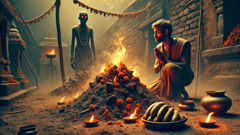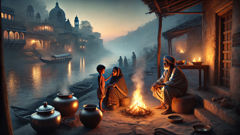Introduction
When the last pyre guttered to ember and ash, the villagers shut their doors and listened. From the thin, blue smoke that rose over the cremation ground came a language older than many gods and younger than the memory of those who once loved their dead: a rustle of skirts, a whisper of teeth on bone, the faint tearing that belongs to hunger not yet sated. The dead had been sent on their long way; the living stayed awkwardly near lantern light, aware that between the ash and the night a different order asserted itself. They called this place kapalaksha, the eye of the skull. They called the thing that prowled there pishacha.
The pishacha is not merely a demon in the way a story-book fiend might be. It is a knot of grief and betrayal, a hunger turned to appetite, an echo of a life that refused to let go. In some accounts it was once a human—a sinner, a butcher of the weak, a person who died in disgrace and whose restless soul re-formed as something obscene. In others it is older still, a being from the world that braided itself with ours at the borders where fire meets air. Priests recite mantras against it; mothers tie talismans for their children; boys dare one another to walk the flank of the ghats at dusk to see if the shadows will press against them in reply. Yet there is always the feeling, even among those who know the words, that the pishacha answers not only to ritual but to story and to hunger, to the precise shape of loneliness left in the wake of a life.
This is a tale braided of small things: an old woman who barters incense for safety, a cremation-ground keeper who knows a secret prayer that bends the will of the pishacha for a season, and a child in whom the demon takes root. It is also a tale of customs and the fragile bargains human communities make with forces they both fear and depend upon. In the hush between two generations this story remembers origins—some told in Sanskritic cadence and others in village murmurs—so that the pishacha may be known, named, and, perhaps, negotiated with rather than obliterated. It is a journey to the edge of ashes, where the living press tiny offerings into cooled coals and listen for answers from mouths that will not speak. If you walk with me now, keep a light at your hip and a kind name in your mouth. The night will ask why you carry such things, and the pishacha will test whether your heart is heavy enough to feed its questions.
Ashes and Origin: The Pishacha's Roots
The oldest stories claim pishachas as part of the world's early unruliness: responses to duties left undone, to gods dishonored, and to familial vows broken in a world where social bonds were both sanctified and precarious. In certain scriptures and tantric treatises the pishacha is described with anatomical cruelty—an appetite that does not stop at flesh but seeks the essence of a human being: memory, speech, the warmth of recognition. Such descriptions are less a taxonomy than a warning. They tell the listener what a pishacha desires and, therefore, what must be protected. You must guard speech for your kin, they say; you must keep your rites spotless; you must avoid deaths that leave the soul adrift.

Villagers told of births that occurred in the shadows of funeral grounds, of infants who arrived with a restlessness no lullaby would soothe. They whispered of the curse that comes when a family neglects the rites of the dead: a broken ritual is like an open wound, and pishachas are attuned to every slip. Offerings left half-burned at dusk, a prayer sung too softly, a name forgotten—any such omission could call a pishacha. Priests fortified their mantras with specific vowels and tones; the sound, they maintained, keeps the boundary intact by making a rhythm too structured for an unbound hunger to inhabit. Yet even the most careful chanting only damps the edges of these beings; the pishacha's appetite is patient and inventive.
Practicality shaped belief as much as doctrine. Those who tended the ghats had rituals that read like freighted chores: to sift ember ash for bone fragments, to take the unclaimed trinkets and cast them into the river, to smear holy ash on a child's brow before letting them play near the watershed. A pishacha could not abide the smell of certain herbs—kadamba blossoms, neem smoke, the resinous tang of frankincense—and being raised on those odors, a child of a family might carry a scent that marked them as less vulnerable. There were also stories of bargains: a cremation-ground keeper could feed a pishacha the shadow of a life by dropping a coin and a half-burned thread into the embers in exchange for years of protection. The coin would not buy the demon; it offered, instead, a named and contained dependence. A trade of this sort bends both parties into a temporary accord.
Yet these bargains allowed for tragedy. A keeper without heirs might promise a pishacha a sort of stewardship, believing that naming a hunger kept it honest. Instead the pishacha would learn to speak the keeper's name better than the keeper ever did, and hunger became mimicry: the demon imitated laughter, the demon forged intimate memories and then used them to tear a family's trust apart. Possession narratives complicate our sense of the pishacha. When a person is taken, the village sees changes in appetite and voice—little aggressions, a child's refusal to bathe, an elder's knack for languages that were never spoken at home. The demon's smallest theft is the misplacement of a sentiment, the highest is rendering the beloved unrecognizable.
Ritual and law responded. Expiatory rites can be lengthy and elaborate: an eight-night series of ceremonies that involve the recitation of specific stotras, the placement of mirrors to reflect the demon's gaze back onto itself, and the smearing of turmeric and cow-dung ash as both a protection and a reproof. Mirrors are historically interesting in this context: in certain villages elders insisted that a pishacha cannot bear its own reflection, perhaps because recognition is a form of accountability that most aspects of the demon world were never given. But story and practice live in tension. Not all pishachas are coerced by ritual. Some are changed by the compassion shown to them: a demon who once feasted in the open might, upon being offered a bowl of kheer and a spoken name, return the favor in an odd, conditional tenderness. This is an idea the poets of the ghats favored—the notion that even the appetite could be modified by attention and ritual kindness. That is a dangerous mercy, because it requires the living to extend beyond fear into a territory where they might be exploited or healed.
Legends of origin also offer striking metaphors. One such tale speaks of a woman who was buried alive by the jealous husband of a merchant. Her voice, swallowed by the earth, turned to a hunger that could not find an outlet. She rose as a pishacha whose mouth was always damp with the memory of her own voice. Another claims that pishachas were once celestial beings who fell for the wrong kind of love, their appetites transformed into something destructive by their own desire. These variants perform cultural work: they frame the pishacha as a living commentary on social wounds—violence against women, the neglect of the poor, kinship ties severed by greed. The pishacha thus becomes a figure not merely of supernatural fear, but of social indictment.
Throughout, the cremation ground remains the pishacha's favored geography. The transient combustions—household curtains thrown into flame, the heady volatilization of perfumes—mark the place as perennially charged. In the cool hours after funerals, the smell of ash is thick and intimate, and that intimacy breeds stories because it is where an ordinary body is shown to be compositionally fragile: muscle, mud, ritual, and then smoke. The pishacha feeds on the finality and the half-finished utterances, on names not given or given incorrectly. When families travel far and leave their dead unattended, the cremation site's social vacancy invites a certain metaphysical vacancy. Without witnesses to bear the memory of a life, the life itself becomes vulnerable to being repurposed by hungry things.
In some modern retellings, the pishacha becomes a metaphor for trauma that returns at night. Survivors of violence recast the demon as an intruder that sits in the sleeper's mouth and names what cannot be spoken. It is a useful conceit: trauma does indeed consume speech, history, and the present in ways that are terrifyingly similar to the pishacha's appetite. Villagers who still live beside the ghats will tell you, not unkindly, that their ancestors invented the pishacha to name what they could not otherwise handle: the waste of war, the children abandoned when famine came, the shame that refuses to be spoken aloud. Thus, the being is both literal and allegorical, a creature of ash and also an index of human failing.
So the argument continues across generations: are pishachas monsters to be exorcised, or mirrors to be tended? The question shapes how communities act in moments of grief. Their answers determine the architecture of rituals, the jobs some people take to live with the dead, and the stories they whisper to their offspring before sending them to pluck the jasmine that grows too close to the pyres. A pishacha's lore teaches a kind of social hygiene: maintain your rites, preserve your memory, feed your neighbor. In a culture where the boundary between life and death is porous and where grief is ritualized into public acts, the pishacha emerges as an ethical fulcrum—one can be taught to fear it or taught to care for that which its hunger reveals.
Possession and the Bargain: A Village Tale
It was in the narrow, river-bent village of Haripura—where the houses leaned toward one another as if to stay warm—that a single winter made the pishacha more talkative than usual. Haripura had always been a village that took death personally. They were compacted of close kinship, and their cremation ground lay only a small walk from the wheat fields. They knew the songs for grief and the exact proportions of offerings required to ward off lesser spirits. They had a keeper of the pyres, an old man named Ramu, with a face like a parched leaf and hands that smelled permanently of soot. Ramu had held his post longer than anyone remembered and had a list of small customs that kept their edges sharp: a thread tied to the right ankle of any newborn for three months; water mixed with rose and cast on the coals every tenth night; and a whispered line before sleep, a line that had been taught in the hush of kitchens and passed like a jar of spice.

No one could say why the pishacha chose that winter, as if the demon worked by a calendar no one else had access to. Perhaps it was the famine that made the villagers skimp on offerings; perhaps it was warfarin left in an unused grain sack; perhaps it was merely boredom—apparently demons have seasons of curiosity. It started small: the baker's son refused bread, the midwife laughed in the wrong places, a married woman woke knowing with perfect clarity the name of a girl she'd long forgotten. Such slippages might have passed if not for the child, Meeta.
Meeta was eight, with eyes like small stones, and she returned one dusk to her parents' courtyard singing. The melody was not from any song known in Haripura: it doubled over itself in strange cadences and had a word repeated that meant nothing to her mother but sounded, when said aloud, like an intake of breath. After that the child's sleep shrank. She began to wake with smudges of ash on her wrists and tiny punctures of pain along her scalp. She would stare at her reflection and press at the air with fingers that tasted like copper. At night she would climb to the rooftop and whisper names—names of people who had never been spoken in the village—until the wind took them and sometimes said them back.
The family grew afraid. They took Meeta to the local healer, a woman who braided her hair with neem leaves and kept an iron trident behind her hut for good measure. The healer tried fumigations: neem smoke, the bitter tang of turmeric boiled in milk, garlic hung like amulets from the child's neck. When Meeta shrieked so loud that the village dogs scattered, someone remembered Ramu. The keeper, more used to bargaining with coal than with living breath, came to the house at dusk carrying a small clay bowl. He had his own prayer—one he kept like a secret coin. It involved the recitation of a handful of careless words and the offering of a scrap of cloth from his own shroud. Ramu's bargain was typical of his sort: you feed the hunger a sign, not a person; you tie the hunger to an object and bind it with memory.
What Ramu saw when he looked at Meeta was not wholly a child. There were moments her pupils flashed black and then returned; there were times when the child's voice grew hoarse with synonyms of grief. They performed the ritual at the edge of the cremation ground, Ramu's bowl between the cold coals. He called to the pishacha using a name only the keeper knew—one the demon had adopted when it had spent a season near his own pyre. Bartering with demons, the elders taught, always involved naming. If you cannot name what you owe, your language falls apart and so does your bargain. Ramu spoke the name, poured a little kheer at the bowl's edge, and laid a scrap of stitched cloth on the coals. The wind took the edge of the cloth and the ashes swallowed the sweetness.
For a while, Haripura breathed easier. Meeta ate rice again, the strange names fell silent, and the nights felt ordinary. But bargains harbour a shorthand cruelty: they are temporary expedients. In Haripura it was simple arithmetic: the pishacha had been given a thing to feed upon, so it changed its hunger. It began to recite incomprehensible fragments of the villagers' own songs, imitating a lullaby to which Ramu's own hands had once belonged. The demon's mimicry unsettled people in ways the cure had not anticipated. They could not tell whether they had gained time or had simply shifted the seat of hunger.
The pishacha's mimicry deepened into possession. Meeta would sometimes sleep for days, her skin waxen and her breath slow. When she awoke, she trod the line between old sorrow and new knowledge, naming details about absent travelers, describing a market on the coast where none of them had ever been. Then one night she spoke a sentence that had no business in a child's mouth: "Feed the ledger, then the ledger feeds you. Feed the ledger, then the ledger remembers." The villagers heard in it something like a law: debts were not numbers on paper but a tally of memory and attentions owed. That phrase became a new kind of charm and a new kind of terror because it suggested that the pishacha took ledger-ness seriously. It kept account.
The episode culminated not with ritual alone but with empathy's dangerous arithmetic. Meeta's mother, an unremarkable woman with callused palms, did something the healers forbade: she sat in the cremation ground at night and told the pishacha stories of the child when the demon came near. She spoke of Meeta's first scraped knee and the way she had once rescued a lizard from a drain. Stories, the village had always known, could bind a demon—or could teach it new ways to hunger. The mother offered a different bargain: not an object but a memory. She did not demand the pishacha leave; she asked it to recognize the child as someone with a past and not merely as food. What the villagers did not anticipate was that recognition itself could be a balm. The demon, unused to being called by ordinary tenderness, hesitated as if a muscle newly stretched.
There was a cost. The pishacha took a memory of its own—a recollection supplied by the mother in exchange—that would haunt the village for a year. It kept the taste of the mother’s voice and used it as a motif in shadowed hours, making everyone hear phrases of lullaby when they dug clods for planting or lit their lamps at dusk. The bargain had spared Meeta but rearranged the village's dream-life. Some called it salvation; others called it a theft, an infection of tenderness that would seed future hunger. Ramu, the keeper, muttered that deals with demons were never sheets but quilts: they wrap and they smother in equal measure.
Haripura adapted. They amended rituals, lengthened the offerings, taught children the specific cadence of the clearing prayer. Meeta grew older and bore the marks of her encounter: she avoided mirrors and had a habit of tracing the ash line of a pyre with her fingertips. Ramu, too, changed; he stopped accepting payment in coin alone and began to ask for stories, for names to be told aloud at the edge of the coals so that memory would stack itself like kindling. The village's social life retooled around these lessons. People who had once kept things within themselves began to speak them at dusk; the public took on a greater role in the domestic. It had an odd civilizing effect: when you know the pishacha might come for a private omission, you are incentivized to make your omissions public.
The tale of Haripura is not inconsequential. It is instructive in showing how a community negotiates with an entity that both threatens and enforces communal norms. The pishacha's presence turned private neglect into public responsibility; it forced housekeepers to see rituals not as superstition but as mechanisms of social memory. Yet the story also warns against a complacent faith in ritual alone. There will always be a pishacha that outsmarts the rite, that delights in imitating maternal voice, that finds pleasure in the precise inflection of a father's laugh and uses it as a knife. What remains luminous in Haripura is the simple, awkward humanity of those who, faced with a monstrous appetite, choose to barter with tenderness rather than only with fear. In their choice is a complicated moral, one neither wholly victorious nor purely tragic: that in naming and telling and sometimes feeding memory itself, humans may craft a tenuous, imperfect protection.
Outsiders who read the folktale might see only spectacle—the child possessed, the demon bargained with, the pyres glowing under moonlight. Those who live by such stories know something subtler: that the pishacha functions as a long-term social mechanism for dealing with absence and disgrace. The daemon is a yardstick of responsibility. Communities that maintain attention, who keep names and voices present, find fewer hauntings. Those that forget remain available for a world in which hunger takes the shapes of mimicked speech and stolen tenderness. The moral is, in the end, prosaic: care for the dead, keep your customs, speak aloud what you love—because a hungry thing will only perform the record you leave unattended.
Conclusion
Across India, in whispered temple-side recitals and in the pragmatic lists of village keepers, tales of the pishacha weave together a cultural fabric of sorrow and caution. They teach that rituals are not mere formalities and that the way a society treats its dead shapes the vulnerabilities of the living. The pishacha, as creature and metaphor, presses at the fragile edge of memory—hungry for omissions, skilled at mimicry, and relentless as the tide. But the stories also insist on a countervailing tenderness: the possibility that memory given, names spoken, and rituals kept create forms of protection that bend the demon's appetite into something that can be negotiated with if not eradicated. To live alongside the knowledge of pishachas is to accept the persistent work of remembrance, to tend the ledger of debts owed in shared voice, and to know that, sometimes, the smallest offerings—an evening song, a bowl of kheer, a name said aloud—are the measures by which communities hold off their deepest hungers. We tell these stories not solely to scare but to instruct: keep your rites, feed your memory, and do not let the quiet moments remain unaccounted for, for there are beings that will keep ledger when you forget.













